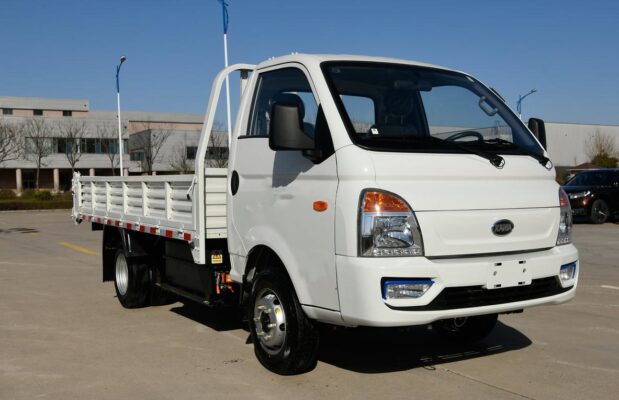Habari za Lori la Umeme
Why Are Electric Vehicles So Fast?
Gari la umemes (EVs) have become increasingly popular, and one of the key reasons for this is their remarkable acceleration and ability to achieve high speeds. EVs are not just eco-friendly alternatives to traditional combustion engine vehicles, but also represent a significant advancement in performance, offering quick acceleration and impressive top speeds. But why are gari la umemes so fast? To answer this question, let’s take a deeper look into the mechanics behind their rapid acceleration and high-speed capabilities.
The Secret Behind Electric Vehicle’s Quick Acceleration
One of the most celebrated features of gari la umemes is their fast acceleration. Unlike traditional gasoline-powered vehicles, which rely on complex engines and gear mechanisms, EVs offer instant torque from their electric motors. This is one of the reasons why they accelerate so quickly.
Electric motors are inherently different from internal combustion engines (BARAFU). In an ICE, torque is generated gradually as the engine’s RPM (revolutions per minute) increases, which means the vehicle must build up speed slowly. On the other hand, electric motors produce maximum torque instantly. This means that when the driver presses the accelerator, the vehicle responds immediately with full power.
This instant torque is possible due to the characteristics of the electric motor. Traditional gas engines must go through a process of combustion and mechanical processes that take time to ramp up. Hata hivyo, electric motors operate differently, providing a direct flow of energy without these delays. In addition, many electric vehicles use a direct-drive system, eliminating the need for a transmission, which not only simplifies the design but also reduces energy losses and increases efficiency. As a result, EVs can accelerate more quickly compared to their traditional counterparts.
Another factor contributing to the rapid acceleration of EVs is their battery technology. Modern EVs are equipped with high-performance lithium-ion batteries, which can quickly discharge energy to the motor, allowing for swift power delivery. The ability to draw a high amount of power in a short time enhances the vehicle’s ability to accelerate.
Why Are Electric Vehicles Capable of High-Speed Driving?
Electric vehicles are not just about fast acceleration—they are also engineered for high-speed performance. There are several reasons why EVs can maintain high speeds over extended periods, making them just as capable as conventional vehicles in terms of top speed.
- Wide RPM Range of Electric Motors: Unlike internal combustion engines, which typically operate efficiently within a narrower RPM range, electric motors are capable of functioning over a much broader range of speeds. This means that even at high speeds, the electric motor can continue to provide the necessary power to sustain the vehicle’s velocity without significant loss of efficiency. The smooth and continuous power delivery ensures that the vehicle can reach and maintain high speeds without a noticeable drop in performance.
- Energy-Dense Lithium-Ion Batteries: One of the major breakthroughs in EV technology has been the development of high-density lithium-ion batteries. These batteries are capable of storing a large amount of energy relative to their size and weight, providing a sufficient energy supply to support both rapid acceleration and high-speed cruising. In addition, battery management systems are designed to optimize the energy flow, ensuring that the motor receives a steady and reliable supply of power, even at high speeds.
- Lightweight Design and Aerodynamics: Electric vehicles are often designed with lightweight materials to maximize performance. Manufacturers use aluminum, carbon fiber, and other composite materials to reduce the vehicle’s overall weight. A lighter vehicle requires less energy to maintain high speeds, thus improving both speed and energy efficiency. Zaidi ya hayo, EVs tend to be designed with aerodynamic efficiency in mind, further enhancing their ability to cut through the air at higher speeds. Streamlined body designs and reduced drag help EVs achieve better high-speed performance compared to heavier, less aerodynamic conventional vehicles.
- Regenerative Braking: Another innovation that supports high-speed driving in EVs is regenerative braking. This system converts some of the kinetic energy produced during braking into electrical energy, which is then stored in the battery for later use. Not only does this help to extend the vehicle’s driving range, but it also ensures that the vehicle can maintain a steady energy supply while driving at high speeds, which is essential for sustained performance.
Is It Safe for Electric Vehicles to Drive at High Speeds?
As EVs continue to evolve, safety remains a top priority, especially when driving at high speeds. While many people might worry that the fast acceleration and high speeds associated with electric vehicles could compromise safety, manufacturers are implementing various technologies to ensure that EVs remain stable and safe, even under extreme conditions.
- Chassis and Structural Integrity: Modern electric vehicles are designed with safety as a primary concern. Many EVs feature reinforced chassis and body structures to ensure the vehicle remains rigid and stable at high speeds. The design of the body and the placement of the battery pack are optimized to improve the vehicle’s overall balance and handling, preventing unwanted sway or instability during high-speed driving.
- Advanced Suspension Systems: EV manufacturers often use sophisticated suspension systems to ensure that the vehicle remains comfortable and stable at high speeds. These systems are designed to absorb road irregularities and minimize body roll, which is particularly important when driving at high speeds. Electric vehicles also benefit from lower centers of gravity due to the placement of heavy batteries near the floor of the vehicle, which further enhances stability and handling.
- Advanced Safety Features: Many electric vehicles come equipped with a range of intelligent driver assistance systems (ADAS), such as lane-keeping assistance, adaptive cruise control, and automatic emergency braking. These systems work together to improve safety by helping drivers maintain control of the vehicle, even during high-speed driving. Zaidi ya hayo, many electric vehicles are equipped with advanced traction control and stability control systems to prevent wheel slip and loss of control, particularly when accelerating or cornering at high speeds.
- Enhanced Brake Systems: High-speed driving also demands an efficient braking system. EVs are typically equipped with advanced brake systems, including regenerative braking, to ensure that the vehicle can stop quickly and safely, even from high speeds. Regenerative braking systems help provide additional stopping power, while traditional hydraulic brakes are tuned to handle the stresses of high-speed deceleration.
Does Driving at High Speeds Affect the EV’s Range?
While electric vehicles are capable of reaching high speeds, one trade-off that many drivers will notice is a reduction in range when driving at higher speeds. This is because maintaining higher speeds requires more energy. The faster an EV goes, the more energy it consumes to overcome aerodynamic drag, rolling resistance, and other factors that increase with speed.
At high speeds, EVs require more power to maintain their velocity, which can cause the battery to drain more quickly. As a result, driving at high speeds on highways or freeways will typically reduce the range compared to city driving, where speeds are lower, and braking and acceleration are more frequent, allowing the vehicle to benefit from regenerative braking.
Hata hivyo, as battery technology continues to improve, manufacturers are making strides in increasing the energy density of batteries. This means that even at higher speeds, modern EVs are able to maintain relatively good range, with some models offering ranges over 300 miles on a single charge, even at highway speeds. With advances in energy storage and efficiency, it’s likely that future electric vehicles will be able to sustain higher speeds for longer periods without significantly compromising range.
Comparing the High-Speed Performance of Electric Vehicles and Traditional Cars
Electric vehicles offer several advantages over traditional gasoline-powered cars when it comes to high-speed driving, but there are also some factors that make conventional vehicles still competitive in certain situations.
- Instant Torque vs. Gear Shifting: One of the primary advantages of electric vehicles is the ability to deliver torque instantly without needing to shift gears. In a traditional gasoline-powered car, the engine needs to rev up and shift through gears, which can cause delays in acceleration. In contrast, EVs have a direct-drive system that provides smooth, uninterrupted power delivery, resulting in faster acceleration and a more seamless driving experience at high speeds.
- Performance Consistency: Electric motors are known for their consistent performance, even at high speeds. Unlike internal combustion engines, which can experience a loss of power as they approach their maximum RPM, electric motors continue to operate efficiently across a wider range of speeds. This makes EVs more reliable in terms of sustained high-speed driving.
- Fueling vs. Charging: Despite the high performance of electric vehicles, one significant challenge they still face in comparison to traditional cars is the refueling process. Gasoline cars can quickly refuel at a gas station in a matter of minutes, whereas EVs typically require longer charging times, especially if they need to be charged to 80% or more. This means that for long road trips, EVs may require more planning to find charging stations along the route, and the time spent charging could be a significant factor in overall travel time.
- Cost of Charging vs. Fueling: Although electric vehicles have higher upfront costs compared to traditional vehicles, the cost of charging an EV is typically much lower than the cost of gasoline per mile traveled. Over the long term, EV owners can save money on fuel, especially with the increasing availability of public charging infrastructure and home-charging solutions.
Hitimisho
Electric vehicles are not only faster than many people think but are also built for sustained high-speed performance. The key to their speed lies in the combination of instant torque from electric motors, high-energy batteries, lightweight designs, and advanced performance technologies. Although driving at high speeds can reduce the vehicle’s range, improvements in battery technology are continually addressing this challenge, ensuring that EVs are more than capable of meeting the demands of everyday driving, including long-distance trips.
While there are still some challenges to overcome, such as the need for faster charging infrastructure, the overall performance of electric vehicles in terms of speed, ufanisi, and safety is undeniably impressive. As technology continues to evolve, electric vehicles will likely become even more efficient, powerful, and capable of handling long-distance travel, ultimately providing a competitive alternative to traditional gasoline-powered vehicles for drivers who demand both speed and sustainability.





